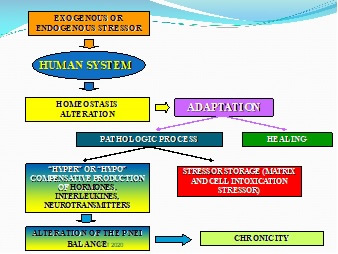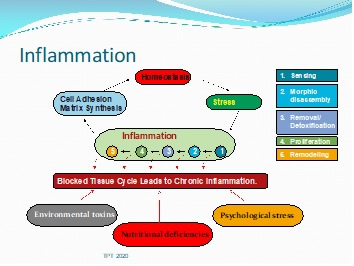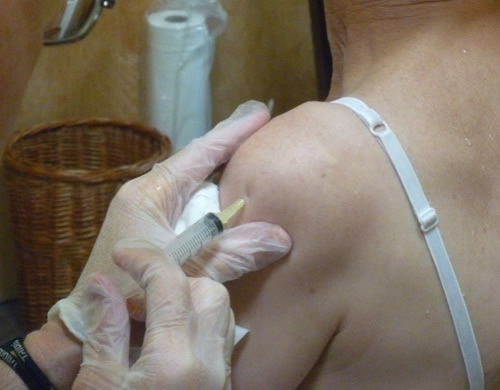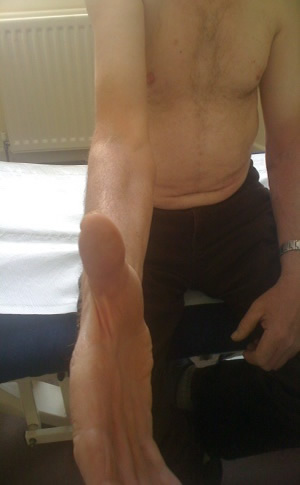Positive Health Online
Your Country

Working With the Healing Properties of Inflammation
by Jonathan Lawrence(more info)
listed in craniosacral therapy, originally published in issue 277 - March 2022
I have worked with an osteopathic approach to treating patients for the best part of 40 years. In the last 25 I have used homotoxicology alongside osteopathy. This has added a new dimension to my ability to help patients. It allows me to help more people. It often helps to speed up the healing process. The principles behind the modality helps one to gain a more profound understanding of the ability of the organism to regain and maintain health.
In particular the importance of inflammation in the role of healing and in the maintenance of chronic disease states is illustrated through the application of these remedies. (Fig1)

Fig 1. Homeostasis and Adaptation
Homotoxicology was developed by Hans Heinrich Reckeweg a German doctor. Reckeweg noted that the modern medical landscape was characterized by an increase in chronic conditions as acute illnesses became less of an issue with improved living conditions, the development of antibiotics and other drugs. He estimated that when homeopathy was being established in the early 19th century the ratio of acute to chronic conditions was 8:2 whereas in the 20th century this was reversed.
These chronic conditions he concluded were due to ‘homotoxins’, that is substances that are poisonous to humans. These homotoxins can be generated within – endogenous, as the result of metabolic disorders or chronic infections. They can also be toxins that come from the environment. He called these exogenous. Disease results from the inability of the body to process and eliminate these chemicals. These toxins can accumulate in the extra cellular matrix.[1]
Reckeweg viewed homotoxicology as a bridge between homeopathy and conventional medicine. He stated that the three pillars of homotoxicology are:
- Drainage and detoxification. This involves enabling or stimulating the organs of elimination. These include the lymph, kidneys, the liver and the gut.
- Immunomodulation, via the control of inflammation.
- Organ support.
An up-to-date introduction can be found here.[2]
He devised medicines that used single homeopathic remedies or a combination of remedies to help achieve a physiological objective to achieve the above. He did this by combining remedies that are synergistic in action.
- The remedies are prepared in various potencies/dilutions. The lower dilutions have active ingredients present in significant quantity and the higher potencies have little or no active ingredients. D potencies are successively diluted 1-part active ingredient to 9 parts water. They are ‘potentized’ by being vigorously succussed (shaken). The first dilution is D1, the second D2 etc.
- Dilutions between D1-5 are sedating. And used for more acute symptoms.
- D6-15 mimic physiological dilutions and tend to be modulating in effect. These dilutions are equivalent to the concentration of hormones in the blood stream.
- D16 upwards are stimulating and better for chronic and mental-emotional symptoms. The higher dilutions are thought to be unlikely to contain active substance and therefore the exact mode of action is unclear, although there are a number of promising candidates in the scientific literature. These mostly involve properties of water. I recommend watching the presentations from the London conference New Horizons in Water Science. Evidence for homeopathy?[3]
As well as botanicals and tissue salts other remedies may include, nosodes (remedies made from disease tissue), sarcodes (made from healthy tissue usually from pigs), and potentized catalysts and immunomodulators. These can be very sophisticated.
Drainage remedies target the improvement of function in the lymphatic system, the liver, kidneys and gut. Remedies for lymphatic drainage incorporate remedies from herbs such as geranium and nasturtium, classical homeopathic remedies and tissue salts. They tend to be in the lower potencies and therefore have some active ingredients.
Remedies for organ support may contain botanicals and classical homeopathic remedies plus sarcodes and metabolic agents such as coenzymes or metabolic components for example elements of the citric acid cycle.
Inflammation
Inflammation is found to be a key factor in dysfunction from acute pain to chronic illness. The term inflammation has negative connotations, nevertheless inflammation is a by-product of the body’s ongoing repair mechanisms and allows the body to adapt to an ever-changing environment. The body goes through pro and anti-inflammatory cycles, for example at night inflammation is at the peak which allows bodily resources to be focused on regeneration and renewal.
In acute injury inflammation gives rise to heat, pain, bruising and swelling (calor, dolor, rubor, tumor). This process subsides when the repair process has completed. However, when the process is blocked and thus cannot complete, chronic inflammation occurs and the process is ongoing. Use of anti-inflammatories such as NSAIDs will indiscriminately block Inflammation. While this may make the patient more comfortable and functional, it will tend to slow the healing process. If used long term it can affect repair systems significantly.
Cancer, heart disease and many other serious illnesses are associated with chronic inflammation.
Reckeweg’s remedy to control inflammation (immunomodulation) is widely used in sport including Olympic teams and professional football. Ingredients are botanicals in low potency and have been selected for their properties in regulating the inflammatory process.
The remedies address the 5 stages of inflammation (Fig 2).

Fig 2. The inflammatory process.
The remedies can come as tablets, creams and injectables.
In practice I have found the remedies helpful in managing chronic conditions such as osteoarthritis, adhesive capsulitis, disc pathology and lateral epicondylitis.
I also find that injecting the remedies can give what Kerschott[4] calls a turbo effect allowing the remedies to act quicker and in some cases more effectively.
The method I use involves the injection of small quantities of remedies in multiple sites, subcutaneously, intra-cutaneously or intra-muscularly using small 13mm needles.
Case Studies:
Frozen Shoulder.
The first study illustrates the treatment of a patient with a history of chronic low back pain who developed adhesive capsulitis of the left shoulder. Margaret, 53 had attended the surgery for treatment to her low back every 6 weeks for several years. It had been observed that less frequent treatments would lead to the development of acute symptoms. Investigations had revealed moderate to severe disc degeneration in the lumbar spine.

Fig 3 Treatment of adhesive capsulitis using remedies for inflammation
and one combination including ferrum phos.
She latterly developed restriction and pain around her left shoulder following a minor accident. This became chronic and adhesive capsulitis was diagnosed. Osteopathic treatment and physiotherapy made little difference in the short term, and it was suggested that she have some injections with homotoxicological agents for inflammation and adhesive capsulitis.
Following injections of the remedies her shoulder improved quickly. However since the injections her back improved significantly to the point where her regular treatments could be spaced out even further.
The videos [4] [5] and [6] illustrates how a shoulder is treated using this method. The model for this is a horse rider who had developed restriction in her left shoulder following a riding accident. A significant increase in movement is apparent following the application of the remedies.
Arthritic Elbow:
Another patient seen in the practice in the early days of using this technique was a farmer of 70 years of age. He had been a regular patient for low back pain management. He also suffered with pain and subsequently arthritis in his right elbow since he dislocated it at 10 years old. It had been fixed in flexion of little more than 90° for some 30 years with limited supination, weakness and loss of sensation in the distribution of ulnar nerve.

Fig 4 Successful treatment of Arthritic elbow. Restriction in extension. Limited supination.
He was treated weekly, then fortnightly with a mixture of remedies. This was followed by rapid improvement including increased supination and greater extension of the joint as well as more sensation and strength in gripping with the 4th and 5th fingers. He estimated 60 per cent improvement in function which was maintained for many years.
These are two illustrations of how homotoxicology helps with osteopathic treatments. Both occurred in the very early days following my qualification in this modality. Since then I have treated many patients such as this with various remedies. One of the great advantages of this system is that side-effects are very rare.
Homotoxicology teaches us that inflammation is our friend and that sometimes the best way to treat the effects of ongoing inflammation is find ways of allow this process to do its job.
References
- Pischinger, A. and Heine, H. The extracellular matrix and ground regulation. Berkeley, CA: North Atlantic Books. 2007.
- Smit, A. Introduction to Bioregulatory Medicine. Stuttgart ; New York: Thieme. 2009.
- New Horizons in Water Science. Full Conference. https://www.youtube.com/watch?v=JB_ZjotrYng&list=PL_ZfccmzItE0gZZUdOQHqxZWBZCB4r_wm
- https://youtu.be/xDlSWADR-jY
- https://youtu.be/L4O1zzo0MKY
- https://youtu.be/cnm1kOi95oo
- Kersschot, J. Biopuncture : the management of common orthopedic and sports disorders. Stuttgart ; New York: Thieme. 2014.
Comments:
-
No Article Comments available